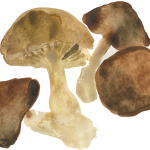Award Winning Author
Face Reading with Before & After Photos
Vegetable Stock
Your own stock outshines any commercial stock in terms of the energy it imparts and the pleasure it delivers. Why’s that? Really ponder the indignities that one carrot would encounter going thru a commercial size factory to be spewed out as product with a shelf-life of more than 18 months. As commercially prepared foods are in a vastly different league than home cooking, use them sparingly.
To enhance the nutrition and flavor of savory dishes, use stock rather than water. You can collect and store clean veggie trimmings in the freezer for your next stock. Or start from scratch by simmering a whole carrot, onion and stalk of celery in a few quarts of water. It’s that easy.
The more delicate nutrients and flavors of vegetable ingredients are compromised by prolonged heat; therefore, cook whole vegetables for about an hour and vegetable pieces for 30 minutes or so. Some ingredients yield their own distinct flavor, like corn cobs, so see recommended vegetables, medicinal herbs and spices below.
I always add a strip of kombu seaweed to stock because kombu adds minerals and naturally—and healthfully—enhances flavor. And, when I don’t have stock on hand, and am making soup, then adding a strip of kombu to the soup-in-progress gives me an instant stock. Also see Bone Stock.
Vegetable Stock
Vegetable scraps
Kombu seaweed (optional)
Sea salt
Place any of the ingredients listed below In a non-reactive pot and cover with water by several inches. Add a minimum of 1 teaspoon salt per quart of water. Bring to a boil, reduce the heat and simmer, with the lid ajar, for 30 to 45 minutes.
Vegetables
The following vegetables, or their trimmings, enhance stock: carrots, celery, celery root, chard, eggplant, green beans, mushrooms, any onion family member, parsley root, parsley stems, potatoes and summer squash.
Spices
Add one or more of the following: several bay leaves, a few cloves, 1 teaspoon allspice, an inch strip orange peel, one-tablespoon chopped ginger.
Medicinal herbs
To enhance your immune system, add one or more of the following: several dried medicinal mushrooms such as shiitake or reishi, ¼ cup jujube (dried red Chinese dates), 3-strips of astragalus, 2 8-inch strips kombu seaweed. Or, use herbs recommended by your herbalist for your specific health needs. Medicinal herbs are available on line or from your local herb shop.
Vegetables NOT Recommended for Stock
Fresh herbs become bitter with long cooking. Strong-flavored ingredients will impart their particular flavor so add them according to how you wish the finished stock to taste: asparagus, fennel, fresh or dried chiles, corn-cobs and husks, green peppers, parsnips, pea pods, tomatoes and winter squash. Artichokes are too intensely flavored. Beets turn the stock red and onion skins tint it brown. Carrot tops are too bitter; as are many cabbage family members, including cabbage, broccoli, cauliflower, rutabagas and turnips.
May you be well nourished,
Rebecca Wood


Sorry, comments are closed for this post.